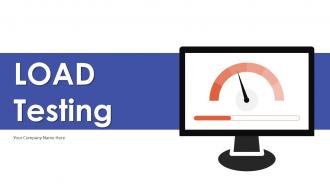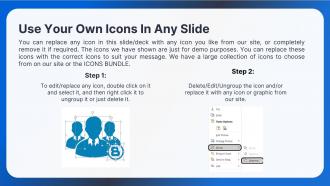Load Testing Powerpoint Presentation Slides
This Load testing PPT includes an introduction and evolution, objectives, key reasons for implementing, advantages and disadvantages, etc. This load testing for scalability success PowerPoint presentation represents types of load testing, high-level premise of load testing, processes, etc. In addition, boosting performance with load testing demonstrates market analysis which includes global load testing software market size, market attractiveness of load testing analysis, etc. Furthermore, deep dive into peak load testing techniques deck discusses architectures of load testing, load testing with other environments such as stress testing, functional testing, performance testing, etc. Moreover, stress testing for robust system performance PPT contains sections about future trends, use cases, applications, best practices, etc. Lastly, this PowerPoint Presentation contains tracking dashboards of load testing and the roadmap for implementing load testing. Download our 100 percent editable and customizable template, which is also compatible with Google Slides.
You must be logged in to download this presentation.
PowerPoint presentation slides
While your presentation may contain top-notch content, if it lacks visual appeal, you are not fully engaging your audience. Introducing our Load Testing Powerpoint Presentation Slides deck, designed to engage your audience. Our complete deck boasts a seamless blend of Creativity and versatility. You can effortlessly customize elements and color schemes to align with your brand identity. Save precious time with our pre-designed template, compatible with Microsoft versions and Google Slides. Plus, it is downloadable in multiple formats like JPG, JPEG, and PNG. Elevate your presentations and outshine your competitors effortlessly with our visually stunning 100 percent editable deck.
People who downloaded this PowerPoint presentation also viewed the following :
Content of this Powerpoint Presentation
Slide 1: This slide introduces Load Testing. State your company name and begin.
Slide 2: This slide states Agenda of the presentation.
Slide 3: This slide shows Table of Content for the presentation.
Slide 4: This slide highlights title for topics that are to be covered next in the template.
Slide 5: The purpose of this slide is to highlight the introduction of load testing and system evaluation as well as the optimizing user experience and reliability of load testing.
Slide 6: This slide is to highlight the objectives of load testing such as performance validation, ensuring system stability, scalability assessment, analysis of response times, etc.
Slide 7: The purpose of this slide is to highlight the reasons for using load testing in software testing such as effective protection against poor performance, etc.
Slide 8: This slide represents the pros and cons of load testing. Some positives are enhancing the system scalability. Some negatives are demands for specialized programming skills, etc.
Slide 9: This slide highlights title for topics that are to be covered next in the template.
Slide 10: The purpose of this slide is to highlight the market size of load testing software by types, applications, industries, etc.
Slide 11: The purpose of this slide is to highlight the market attractiveness of load testing analysis by type such as web-based, cloud-based, etc.
Slide 12: The purpose of this slide is to highlight the future trends of load testing such as self-learning models, intelligent test case generation, automated root cause, etc.
Slide 13: This slide highlights title for topics that are to be covered next in the template.
Slide 14: This slide represents the different types of load testing such as baseline load testing, stress testing, soak testing, spike testing, concurrency testing, etc.
Slide 15: The purpose of this slide is to compare the various types of load testing techniques, such as smoke, load, stress, breakpoint, soak and spike testing.
Slide 16: The purpose of this slide is to highlight the high-level premise for load testing such as establishing the test environment, setting performance criteria, etc.
Slide 17: This slide is to highlight the metrics for load testing such as quantitative measurement, relevance to business process, realistic justification, etc.
Slide 18: This slide highlights title for topics that are to be covered next in the template.
Slide 19: The purpose of this slide is to highlight the process of load testing which includes conducting baseline test, preparing test script, defining test case scenarios, etc.
Slide 20: This slide is to highlight the evaluations of performance of load testing such as the objective of average load testing, simulation of average behaviour, etc.
Slide 21: This slide is to highlight the steps to follow for starting load testing such as gathering requirements, mapping out the user journey, establishing baseline, etc.
Slide 22: This slide highlights title for topics that are to be covered next in the template.
Slide 23: This slide showcases the essential environment setup for successful load testing such as server machines, processors, memory, disk storage, etc.
Slide 24: This slide highlights title for topics that are to be covered next in the template.
Slide 25: The purpose of this slide is to highlight the strategies of load testing such as manual load testing, in-house developed load testing tools, open source load testing tools, etc.
Slide 26: The purpose of this slide is to highlight the guidelines for load testing performance such as timing load testing, data preparation, user count determination, etc.
Slide 27: This slide highlights title for topics that are to be covered next in the template.
Slide 28: This slide is to demonstrate the architecture of load testing process key components of this slide are test scenario, load generation on cloud, on-premises load generation, etc.
Slide 29: This slide highlights title for topics that are to be covered next in the template.
Slide 30: This slide is to highlight the difference between load and stress testing based on objective, SLA consideration, main aim, attributes, load limit, etc.
Slide 31: The purpose of this slide is to highlight the difference between functional and load testing on the basis of predictability, variability, execution frequency, etc.
Slide 32: The purpose of this slide is to highlight the difference between performance and load testing based on evaluation focus, load definition, environmental context, etc.
Slide 33: This slide highlights title for topics that are to be covered next in the template.
Slide 34: The purpose of this slide is to highlight the tools and features used in load testing such as Apache JMeter, LoadRunner, K6, Blaze meter, etc.
Slide 35: The purpose of this slide is to highlight the online tools for load testing such as load impact, flood io, loader, load storm, etc.
Slide 36: The purpose of this slide is to highlight the key approaches to selecting the best load-testing tool such as protocols, ease of use, scalability, etc.
Slide 37: The purpose of this slide is to highlight the architecture of load testing it includes components such as load tool, internet, firewall, load balancer, database, etc.
Slide 38: This slide highlights title for topics that are to be covered next in the template.
Slide 39: The purpose of this slide is to highlight the testing scenarios such as gradual client ramp-up, key test scenarios, monitoring metrics, error analysis, etc.
Slide 40: This slide highlights title for topics that are to be covered next in the template.
Slide 41: The purpose of this slide is to highlight the objectives and outcomes of load testing such as system user capacity and scalability, transaction response times, etc.
Slide 42: The purpose of this slide is to highlight the list of workload modeling scenarios such as browse, product view, add to cart, check out, make payments, etc.
Slide 43: This slide highlights title for topics that are to be covered next in the template.
Slide 44: The purpose of this slide is to highlight the metrics to analyse load testing results such as load test KPIs, notes, played scripts, planned scenarios, network, etc.
Slide 45: The purpose of this slide is to highlight the load test KPIs such as test duration, bot peak, uploading data, aggregate pages, total error, aggregate iterations, etc.
Slide 46: This slide highlights title for topics that are to be covered next in the template.
Slide 47: This slide is to highlight the performance metrics in load testing such as response time, peak response time, throughput, concurrent users, etc.
Slide 48: The purpose of this slide is to highlight the best practices of load testing such as crafting realistic scenarios, testing early and often, setting practical benchmarks, etc.
Slide 49: This slide highlights title for topics that are to be covered next in the template.
Slide 50: This slide is to highlight the challenges and solutions of load testing such as not having a perfect plan, lack of time and resources, using inappropriate tools, etc.
Slide 51: This slide highlights title for topics that are to be covered next in the template.
Slide 52: The purpose of this slide is to highlight the steps to follow for implementing load testing such as defining objectives, selecting appropriate tools, etc.
Slide 53: This slide highlights title for topics that are to be covered next in the template.
Slide 54: The purpose of this slide is to outline the mode, cost, agenda, and schedule for the training programs.
Slide 55: This slide shows the cost breakup of a training program on implementation load testing components, such as instructors' cost, training material cost, etc.
Slide 56: The purpose of this slide is to highlight the budget components for implementing load testing such as testing tools, infrastructure, personnel, etc.
Slide 57: This slide highlights title for topics that are to be covered next in the template.
Slide 58: The purpose of this slide is to highlight the components in the load testing performance monitoring dashboard such as load size, hit time, log message, failed rounds, throughput, etc.
Slide 59: This slide highlights title for topics that are to be covered next in the template.
Slide 60: The purpose of this slide is to highlight the before vs. after such as performance issues, unexperienced, response time, scalability, etc.
Slide 61: This slide contains all the icons used in this presentation.
Slide 62: This slide is titled as Additional Slides for moving forward.
Slide 63: This is a Financial slide. Show your finance related stuff here.
Slide 64: This slide shows Post It Notes. Post your important notes here.
Slide 65: This is an Idea Generation slide to state a new idea or highlight information, specifications etc.
Slide 66: This is Our Target slide. State your targets here.
Slide 67: This slide depicts Venn diagram with text boxes.
Slide 68: This slide contains Puzzle with related icons and text.
Slide 69: This slide shows Logo with additional textboxes.
Slide 70: This slide presents Funnel.
Slide 71: This is a Thank You slide with address, contact numbers and email address.
Load Testing Powerpoint Presentation Slides with all 80 slides:
Use our Load Testing Powerpoint Presentation Slides to effectively help you save your valuable time. They are readymade to fit into any presentation structure.
-
Awesome use of colors and designs in product templates.
-
“One of the best experiences with SlideTeam for my presentation.Everything on time, communication is efficient and price is reasonable. All good in one place.”







































































































































































